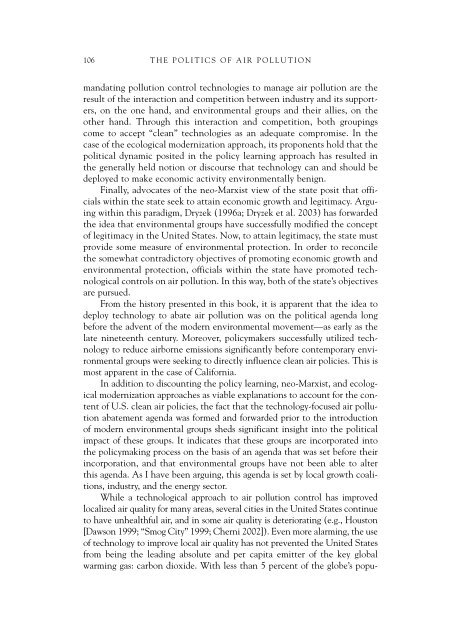GEORGE A. GONZALEZ - fieldi
GEORGE A. GONZALEZ - fieldi
GEORGE A. GONZALEZ - fieldi
Create successful ePaper yourself
Turn your PDF publications into a flip-book with our unique Google optimized e-Paper software.
106THE POLITICS OF AIR POLLUTIONmandating pollution control technologies to manage air pollution are theresult of the interaction and competition between industry and its supporters,on the one hand, and environmental groups and their allies, on theother hand. Through this interaction and competition, both groupingscome to accept “clean” technologies as an adequate compromise. In thecase of the ecological modernization approach, its proponents hold that thepolitical dynamic posited in the policy learning approach has resulted inthe generally held notion or discourse that technology can and should bedeployed to make economic activity environmentally benign.Finally, advocates of the neo-Marxist view of the state posit that officialswithin the state seek to attain economic growth and legitimacy. Arguingwithin this paradigm, Dryzek (1996a; Dryzek et al. 2003) has forwardedthe idea that environmental groups have successfully modified the conceptof legitimacy in the United States. Now, to attain legitimacy, the state mustprovide some measure of environmental protection. In order to reconcilethe somewhat contradictory objectives of promoting economic growth andenvironmental protection, officials within the state have promoted technologicalcontrols on air pollution. In this way, both of the state’s objectivesare pursued.From the history presented in this book, it is apparent that the idea todeploy technology to abate air pollution was on the political agenda longbefore the advent of the modern environmental movement—as early as thelate nineteenth century. Moreover, policymakers successfully utilized technologyto reduce airborne emissions significantly before contemporary environmentalgroups were seeking to directly influence clean air policies. This ismost apparent in the case of California.In addition to discounting the policy learning, neo-Marxist, and ecologicalmodernization approaches as viable explanations to account for the contentof U.S. clean air policies, the fact that the technology-focused air pollutionabatement agenda was formed and forwarded prior to the introductionof modern environmental groups sheds significant insight into the politicalimpact of these groups. It indicates that these groups are incorporated intothe policymaking process on the basis of an agenda that was set before theirincorporation, and that environmental groups have not been able to alterthis agenda. As I have been arguing, this agenda is set by local growth coalitions,industry, and the energy sector.While a technological approach to air pollution control has improvedlocalized air quality for many areas, several cities in the United States continueto have unhealthful air, and in some air quality is deteriorating (e.g., Houston[Dawson 1999; “Smog City” 1999; Cherni 2002]). Even more alarming, the useof technology to improve local air quality has not prevented the United Statesfrom being the leading absolute and per capita emitter of the key globalwarming gas: carbon dioxide. With less than 5 percent of the globe’s popu-









